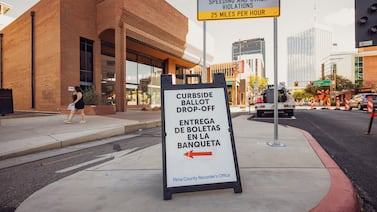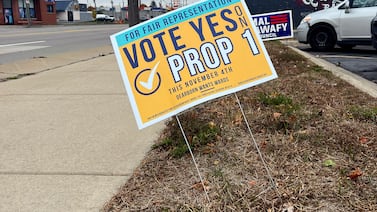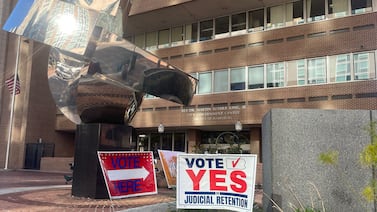Votebeat is a nonprofit news organization reporting on voting access and election administration across the U.S.
This news analysis was originally distributed in Votebeat’s free weekly newsletter. Sign up to get future editions, including the latest reporting from Votebeat bureaus and curated news from other publications, delivered to your inbox every Saturday.
Amid all the worries about the perennially elusive youth vote, there’s a promising trend to talk about: In a growing number of towns and cities across the U.S., 16- and 17-year-olds are gaining the right to vote. The numbers are still small, but the momentum is real. Advocates say it’s about nurturing lifelong voters.
Take Newark, New Jersey, which allowed 16- and 17-year-olds to vote in its school board election in April. Teen turnout was only about 3%. But that was better than the adults managed. Besides, as Sam Novey from the University of Maryland’s Center for Democracy and Civic Engagement puts it, the city “started from nothing.”
Indeed, adding younger teens to the voter rolls involves building a lot of things from scratch. After Newark passed its ordinance last year allowing youth voting, officials had to rewire voter registration systems and launch a full-scale education campaign. It was about 14 months before 16- and 17-year-olds could cast their first ballots.
“Comparatively lightning fast,” Novey said.
And there’s a payoff to look forward to.
“Research shows that those who are allowed to register and begin voting at 16 are more likely to vote later in life than their peers,” said Joshua Douglas, a law professor at the University of Kentucky. “It’s an important way to increase participation.”
In short: Get ’em young, and they’ll keep coming back. The act of voting becomes normal, even expected. And school, Douglas said, is an ideal environment for that first civic nudge — with teachers and peers available to discuss the issues.
The research Douglas cited looked at Scotland, which allowed 16-year-olds to vote in its 2014 independence referendum. The decision was initially controversial, but “nothing bad happened,” said Jan Eichhorn, a political science professor at the University of Edinburgh who studies youth participation and cowrote the study. “Adults realized teenagers were paying attention, often more than adults.”
Public support for youth voting soared in Scotland after that.
The U.S. has been slower to move. Nationwide, the U.S. Constitution guarantees voting rights only for people 18 and older. But at the local level, things are heating up.
Right now, Maryland leads the way. Several municipalities there have already lowered the voting age for local races, taking advantage of state law that makes it easy for municipalities to accommodate registration and ballots for 16- and 17-year olds. A local council vote is enough to change quite a lot of election rules, including, for example, allowing noncitizens to cast ballots.
Compare that with Oakland, California, where voters approved youth voting back in 2020 — only to have to wait four full years for Alameda County to get around to updating its registration systems, a much longer delay than Newark.
In other words, even when the people say yes, the bureaucracy can say, “We’ll get to it eventually.”
That’s what Novey wants everyone to know: that lowering the voting age isn’t just a matter of changing policy. “It touches on a lot of different systems and issues,” he said. Some cities might be able to handle the transition in-house, but others may need new tech, new training, and a lot of patience and support.
In Newark, one of the biggest forces behind the policy was the New Jersey Institute for Social Justice. Attorney Micauri Vargas, the associate counsel for the institute’s Democracy & Justice program who drafted the ordinance, said supporters “knew it wasn’t going to get done statewide,” despite Gov. Phil Murphy mentioning it in his last two State of the State speeches. So they went local, to the state’s largest city, where the mayor and City Council were supportive — and, notably, where the movement had been “started by the students.”
Not everyone was cheering. “People still just don’t feel comfortable with young people having a say in what they think are only money matters, but they aren’t,” Vargas said.
Even some teenagers were skeptical. “But then other young people would ask them if they trusted themselves, and they always said they did,” Vargas said. “They changed their minds.”
This question is about more than voting rules. It’s about trust — not just in systems, but in young people’s ability to shape them. And like Eichhorn said, some adults might just need to spend more time with teenagers to see what they’re capable of.
Of course, there are critics of expanding the franchise this way. Some argue that it’s a slippery slope, or that teenagers are too immature or uninformed to handle voting responsibly. But Douglas points out that we don’t typically take voting rights away from adults on that basis — “even ones who may be legally incompetent. Yet bright, informed 16-year-olds can’t vote.” Fair point.
For now, youth voting in America is a patchwork, enabled by quirks in local laws, driven by ambitious students, and supported by researchers like Novey and his Vote 16 Network, which offers best practices for cities.
And it’s still far from mainstream. But so was same-day registration once. So was voting by mail. So was early voting. All of those ideas sounded radical at some point — until they didn’t.
Chalkbeat Newark Bureau Chief Catherine Carrera contributed.
Jessica Huseman is Votebeat’s editorial director and is based in Dallas. Contact Jessica at jhuseman@votebeat.org.




